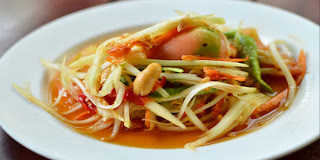Most Popular Mangoes Thai

The mango, known as mamuang in Thai, is one of Thailand's premier tropical fruits, and Thailand produces some of the most delicious mangoes in the world.
Thai mangoes can be eat mainly 2 categories are :
1. Green Mangoes : These are those whose fruits are ready to be harvested and consumed when they are still green and have unique nutty taste, with little or no sour taste. They may be mature but not yet softened. Some cultivars may be eaten when they are half – ripe. In fact, the tendency to eat mango at the half – ripe stage is increasing even among foreigners. This group of mangoes is unique to Thailand since none exists in other countries. Important cultivars of this category are : ‘ Reat’ and ‘Nong Saeng’.
2. Ripe Mangoes : These are those whose fruits are ready for harvest – ing when they are fully mature and ready for consumption when they are ripe. The most popular Nam Dok Mai Si Thong Shape : ovate with sharp pointed tip
Color : golden yellow skin, deep yellow flesh when ripe Taste : sweet and scented Weight : 280 – 300 g They are sour in taste when still green but turn sweet with characteristic aroma and flovor when ripe. We call Nam Dok Mai Si Thong is the Queen Of Mangoes in Thailand good taste beautiful in shape
-->
Foi Thong Thai Desserts

Ingredients
• Yolks from 10 duck's eggs and 5 hen's eggs
• 3 cups of sugar
• 2 cups of water scented with jasmine
• 1 piece of thin white cloth for filtering
Method How to cook
1. Put all the yolk on a piece of thin white cloth, fold it up, and squeeze the cloth to filter the yolk through it.
2. To make syrup, boil sugar in water scented with jasmine in a pot. When all the sugar dissolves, take the water to be filtered before continuing stewing it until bubbles appear all over the surface.
3. Pour the yolk through a narrow funnel which is placed over the pot of syrup so that the yolk will become golden threads in the syrup.
4. Use a long pointed piece of wood to stir the golden threads in the syrup until they become smooth. Then remove them from heat and wrap them around themselves so that they form the shape of a rectangle.
Bua Loi Popular Dessert
 Bua Loi is a popular dessert in Thailand today. It is loved by people of all classes. That's why it is available in many places, ranging from food stalls on the sidewalk to good restaurants.
Bua Loi is a popular dessert in Thailand today. It is loved by people of all classes. That's why it is available in many places, ranging from food stalls on the sidewalk to good restaurants.
Ingredients
• 1 cup of thick coconut cream obtained by grating coconut meat and pressing it for the first time
• 3 cups of glutinous rice flour
• 2 cups of thin coconut cream obtained by pressing grated coconut meat for the second and third times
• 2 cups of sugar
• 1 teaspoon of salt
Method How to cook
1. Mix the flour with water and knead it into a dough.
2. Shape the dough into a number of small balls.
3. Put the balls of dough into boiling water.
4. When the balls float on the surface of the water, spoon them up and put them in cold water before taking them out.
5. Mix 2 cups of thin coconut cream with sugar and salt, and filter it.
6. Place the pot of the mixed coconut cream on a moderate heat. When it is boiling, put the balls in it.
7. When the mixture is boiling again, pour the thick coconut cream into it and remove it from heat immediately without stirring it. It is now ready for serving
Thai Herbs often used in Thai cooking
Many Thai herbs and spices used in Thai cuisine have beneficial medicinal properties.
Chili: "Phrik" in Thai
.jpg)
Chili is an erect, branched, shrub-like herb with fruits used as garnishing and flavouring in Thai dishes. There are many different species. All contain capsaicin, a biologically active ingredient beneficial to the respiratory system, blood pressure and heart. Other therapeutic uses include being a , carminative and anti flatulence agent, and digestant.
Cumin: "Yi-ra" in Thai

Cumin is a small shrubbery herb, the fruit of which contains a 2-4% volatile oil with a pungent odour, and which is used as a
flavouring and condiment. Cumin's therapeutic properties manifest as a stomachic, bitter tonic, carminative, stimulant and astringent.
Garlic: "Kra-thiam" in Thai

Garlic is an annual herbaceous plant with underground bulbs comprising several cloves. Dried mature bulbs are used as a flavouring and condiment in Thai cuisine. The bulbs contain a 0.1-0.36% garlic oil and organic sulfur compounds. Therapeutic uses are as an antimicrobial, diaphoretic, diuretic, expectorant, anti flatulence and cholesterol lowering agents.
Ginger: "Khing" in Thai

Ginger is an erect plant with thickened, fleshy and aromatic rhizomes. Used in different forms as a food, flavouring and spice. Ginger's rhizomes contain a 1-2% volatile oil. Ginger's therapeutic uses are as a carminative, antinauseant and antiflatulence agent.
Galanga: "Kha" in Thai

Greater Galanga is an erect annual plant with aromatic, ginger-like rhizomes, and commonly used in Thai cooking as a flavouring. The approximately 0.04 volatile oil content has therapeutic uses as carminative, stomachic, antirheumatic and antimicrobial agents.
Hoary Basil: "Maeng-lak" in Thai

Hoary Basil is an annual herbaceous plant with slightly hairy and pale green leaves, eaten either raw or used as a flavouring, and containing approximately 0.7% volatile oil. Therapeutic benefits include the alleviation of cough symptoms, and as diaphoretic and carminative agents.








.jpg)












![Yum Woon Sen [Spicy cellophane noodle salad]](https://blogger.googleusercontent.com/img/b/R29vZ2xl/AVvXsEgZavaiIlFGy4ZC-zHE4cH4TfmBPqjkpUHmmedsfBXezlRhUsb1FC50n-NIHG9x3zLXOr1_ObWT7agjrcH6XbLGEMr7L-9NLg_TXBgf6ij03XObkDXq7KTNktz_CL_-B9JI2Qi9p77rtFc6/s72-c/yum+woon+sen.jpg)
![KHA MUN KAI [BOILED CHICKEN AND RICE]](https://blogger.googleusercontent.com/img/b/R29vZ2xl/AVvXsEhEYjkD7LhrtaJRe3y3TM5U9kGKOGgUN8xw7OC9vHS8xkxKZSbnHxDZujlwVLcPTAf4uly9Cz_NZzFTPvs9FqmSeHYEKlcWPYBfGYET9Bfvdd5PLgXU188xMR83g4vcnVyB_6KEaTdFz3ut/s72-c/1882056%255B1%255D.jpg)